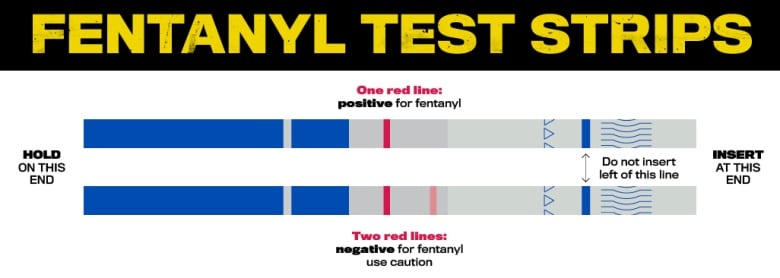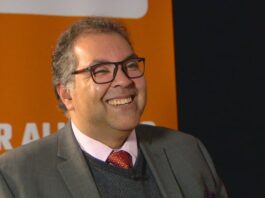
Colleen LaRocque’s 29-year-old son, Mitchell Sveinbjornson, died from a drug overdose in August 2020 after doing cocaine that was laced with fentanyl at a party in southeastern Saskatchewan.
She believes he would have thought twice about taking cocaine if he had known it contained fentanyl, the far more potent and often deadly opioid.
“They managed to get their hands on some tainted cocaine and there were four of them that were there and three woke up. One didn’t,” she said.
“My son had everything going for him. Everything. Loved his job. Loved his kids. Loved his family. This was just a poor decision.”
The registered nurse would like to see fentanyl test strips become as ubiquitous in Saskatchewan as free condoms and COVID-19 rapid tests. The small strips of paper can detect the presence of fentanyl in pills, powder and injectables, but can’t determine the quantity or strength of the fentanyl.

LaRocque would like to see the take-home tests being offered at health centres and pharmacies in Saskatchewan, as well as the libraries, gas stations and grocery stores that handed out free rapid COVID tests during the pandemic. She says naloxone kits should be given out at the same time.
“If we could push, like we did rapid testing for COVID, man we could save some lives,” she said.
More than 1,200 people have died from drug poisoning in Saskatchewan in the past three years. The overdose crisis has stolen loved ones from every part of the province and every walk of life. You can learn about some of them here.
While there is no one-size-fits-all solution to curb the overdose crisis, some grieving families say more services and awareness would help prevent deaths.
‘You’re taking that chance every time’

Cass Wardell, 24, sought help from a psychiatrist for his anxiety and took prescription medicine.
His brother, Don Wardell, said “when the prescriptions ran out and my brother couldn’t get any help anymore, he turned to street drugs. So, after he turned to street drugs, that it was it. It was game over.”
In May 2020, Cass bought Xanax pills from someone he trusted to self-medicate for anxiety. He didn’t realize they were mixed with a deadly dose of fentanyl. Before he fell asleep that night, he divulged that he had big plans to surprise his mother and his fiancée, whom he shared a son with, the next morning for Mother’s Day.
He never woke up. His mom found him dead from a fentanyl overdose.
“There was fentanyl laced in the Xanax without my brothers knowledge,” Don said. “It doesn’t matter [who is giving you the drugs], if that’s your bro, that’s your sister … there’s a chance that it could be laced with fentanyl and that it’s not 100 per cent safe. You’re taking that chance every time.”
Don hasn’t touched drugs or alcohol in two years.
“I can see my little brother just looking down at me, saying ‘Don’t do it. Don’t do it.'”
‘You are not alone’
Like Cass Wardell, Matthew Baraniuk was self-medicating for mental health issues and died from a fentanyl overdose at his parents’ home in Saskatoon.
“Matthew was a firecracker. Like, from Day 1, just so full of life,” said his mother, Shari Baraniuk.

Matthew learned to walk at six months, run at nine months, and didn’t stop moving. From the time he was young, he struggled to deal with attention-deficit hyperactivity disorder (ADHD).
“We, unfortunately, had a family doctor who didn’t really believe in ADHD. His advice to us was, ‘Put him in as many sports as possible and keep him active,'” Shari said.
That helped him become a football star, but it didn’t help him calm his mind or focus. For that, he turned to pills.
“I think when it started, it was [with] a lot of his friends. His sports friends, his high school friends, his university friends, getting prescription pills and taking those pills at parties and in people’s homes.”
On the field, Matthew was excelling. He played for the U of S Huskie football team in his first year of university. But his mental health was deteriorating and his drug use was escalating.
“Athletes are taught to not show weakness and be strong all the time. Again, that message is re-enforced in so many ways, and so he continually felt he had to hide his struggles,” Shari said.

The coroner ruled Matthew’s overdose a suicide because of his past depression, but his mother says no one will really ever know whether Matthew, like so many others, just got unlucky in the Russian roulette of fentanyl-use.
She wants to see better access to mental health services in the education system and the health-care system, and for there to be less stigma attached to seeking help.
“I really want people to reach out to your friends, even though they seem happy, they seem confident. Reach out and let them know that you are there for them,” she said.
“And if you are struggling, please reach out to someone. You are not alone.”
If you are struggling with substance use or having a mental health crisis, help is available.
For an emergency, call 911.
Call HealthLine 811 for 24-hour health and mental health and addictions services. It is staffed by registered nurses, psychiatric nurses and social workers.
Call the Hope for Wellness Help Line if you are an Indigenous person in Canada who requires immediate help. The 24-hour toll-free Help Line is 1-855-242-3310 or connect to the online chat at www.hopeforwellness.ca.
Contact your mental health clinic.
Call Counselling Connect Saskatchewan for free access to rapid access counselling sessions.
Call an emergency crisis hotline.
Call Kids Help Phone for professional counselling, information and referrals. Phone 1-800-668-6868, text CONNECT to 686868 or chat online. It’s confidential, free and available 24/7.












